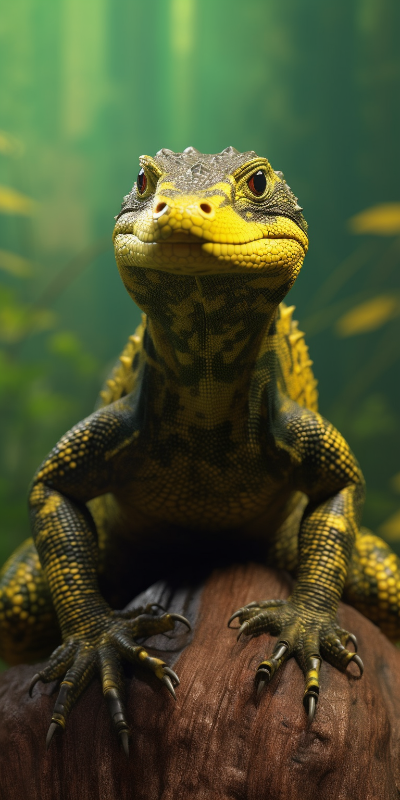The Crocodile Monitor
The Crocodile Monitor, also known as the Varanus salvadorii, is a species of large monitor lizard found on the island of New Guinea. It is known for its impressive size, reaching lengths of up to 10 feet, making it one of the longest lizards in the world. It has a slender body, long tail, and sharp, curved teeth. Its coloration is a striking emerald green, with rows of yellow or white spots running down the length of its back. The Crocodile Monitor is an arboreal species, spending most of its time in trees, and it has strong claws and a muscular tail that aids in climbing.

| Crocodile Monitor | |
|---|---|
| Size | Up to 13 feet (3.96 meters) |
| Weight | Up to 200 pounds (90.72 kilograms) |
| Speed | Speed: 11 mph (17.7 km/hr) |
| Key Strength | Powerful jaws and sharp teeth |
| Biggest Weakness | Slow movement on the ground |
| Scientific Name | Varanus salvadorii |
| Family | Varanidae |
| Habitat | Rainforests |
| Geography | New Guinea |
| Diet | Carnivorous, eats small mammals, birds, reptiles, and eggs |
| Lifespan | 17 years - 20 years |

The Crocodile Monitor
The Crocodile Monitor, also known as the Varanus salvadorii, is a species of large monitor lizard found on the island of New Guinea. It is known for its impressive size, reaching lengths of up to 10 feet, making it one of the longest lizards in the world. It has a slender body, long tail, and sharp, curved teeth. Its coloration is a striking emerald green, with rows of yellow or white spots running down the length of its back. The Crocodile Monitor is an arboreal species, spending most of its time in trees, and it has strong claws and a muscular tail that aids in climbing.
Fun Fact: The Crocodile Monitor is an excellent swimmer and diver, and it can submerge itself underwater for long periods of time, using its long tail for propulsion.
| Crocodile Monitor | |
|---|---|
| Size | Up to 13 feet (3.96 meters) |
| Weight | Up to 200 pounds (90.72 kilograms) |
| Speed | Speed: 11 mph (17.7 km/hr) |
| Key Strength | Powerful jaws and sharp teeth |
| Biggest Weakness | Slow movement on the ground |
| Scientific Name | Varanus salvadorii |
| Family | Varanidae |
| Habitat | Rainforests |
| Geography | New Guinea |
| Diet | Carnivorous, eats small mammals, birds, reptiles, and eggs |
| Lifespan | 17 years - 20 years |
Crocodile Monitor Matchups
We use AI to simulate matchups between the Crocodile Monitor and other animals. Our simulation considers size, strength, and natural predatory behaviors to determine the most likely outcome.

Can't find the Matchup you want?
Create Your Own MatchupCrocodile Monitor: Diet, Predators, Aggression, and Defensive Behaviors
What do Crocodile Monitors eat?
Crocodile Monitors are carnivorous reptiles, with a diet consisting primarily of birds, eggs, small mammals, and other reptiles. They are known to be opportunistic hunters, using their long, sharp teeth and strong jaws to catch and subdue their prey.
Do Crocodile Monitors have any predators?
As adults, Crocodile Monitors have few natural predators due to their large size and predatory nature. However, younger individuals may fall prey to larger predators such as birds of prey, snakes, and other monitor lizards.
Are Crocodile Monitors aggressive?
Crocodile Monitors are known to be solitary and territorial reptiles, often displaying aggressive behavior towards other individuals, especially during mating season or when competing for food and territory. They can become defensive or aggressive when they feel threatened or cornered.
Do Crocodile Monitors fight?
Male Crocodile Monitors are known to engage in fierce battles, especially during the breeding season when competing for females or territory. These fights can involve biting, clawing, and tail whipping, and can result in serious injuries or even death.
How do Crocodile Monitors defend themselves?
When threatened, Crocodile Monitors have several defense mechanisms at their disposal. They may hiss, puff up their bodies to appear larger, lunge, bite, or use their sharp claws and tail to defend themselves. They are also adept climbers and swimmers, allowing them to escape from potential threats by retreating to the safety of trees or water.
What is the biggest weakness of Crocodile Monitors in a fight?
Despite their formidable size, strength, and sharp teeth, Crocodile Monitors have a vulnerable underside that is not as well protected as their back and sides. This vulnerability can be exploited by predators or rival monitors during a fight, making it a potential weak spot in combat situations.
Fun Fact: The Crocodile Monitor has a unique hunting strategy - it waits patiently on tree branches and then lunges down onto prey passing below, using its sharp teeth to inflict a deadly bite.
Fun Fact: The Crocodile Monitor is known for its impressive intelligence and problem-solving abilities, making it a highly adaptable predator in its habitat.












